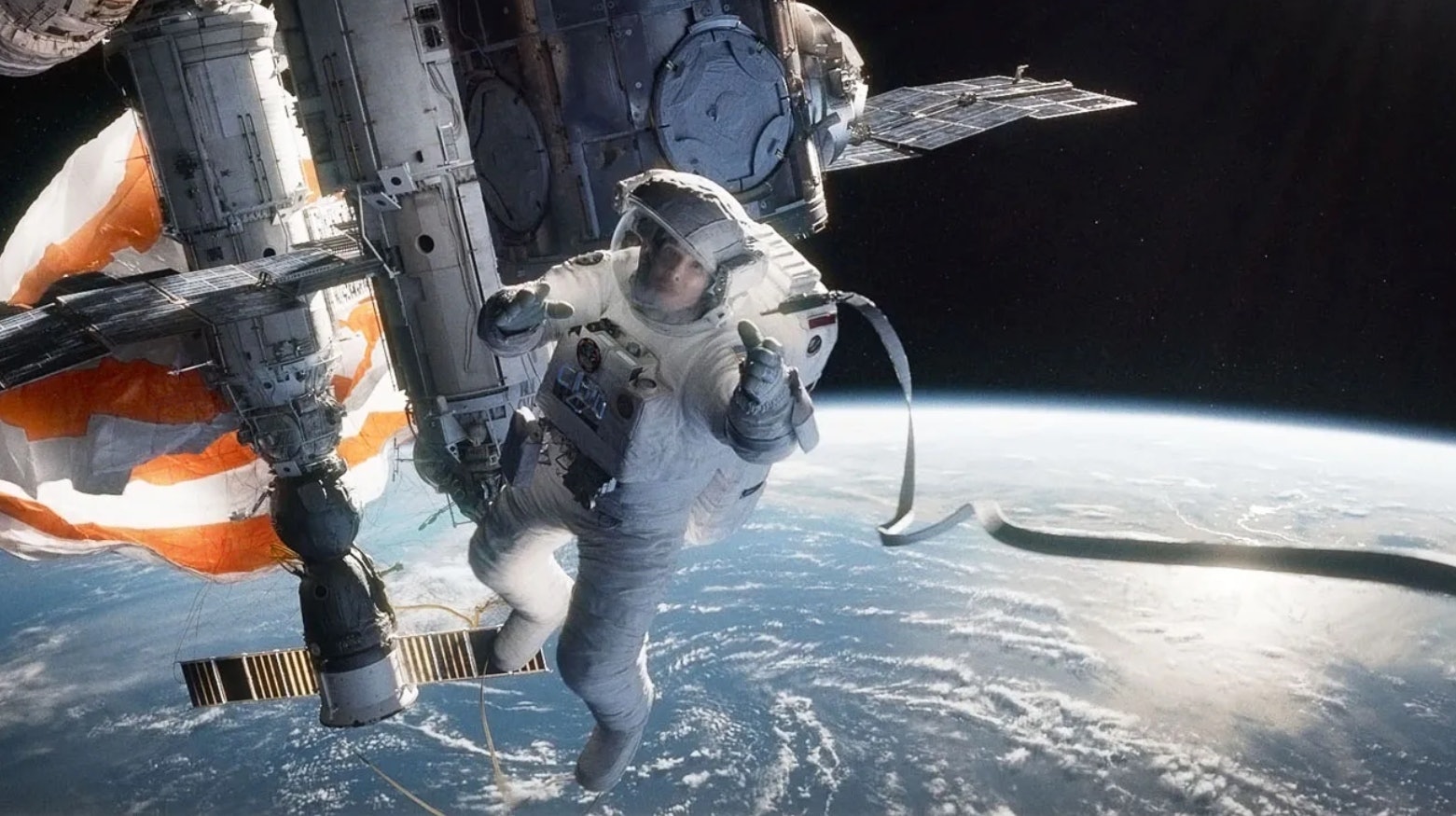
Modern science fiction is surprisingly blasé about the dangers of space, at least when that space isn’t occupied by parasitic aliens and scheming Sith lords. Apprentice Jedi have to deal with many problems, but catastrophic depressurization isn’t one of them. Maybe that’s because we’ve become blasé about space; as NASA’s budget is squeezed and its accomplishments become more difficult to communicate to the public, the final frontier is starting to feel like just another venue for billionaires to show off in. Space exploration is safer than ever, but also less eventful than ever. Anything Elon Musk has his hand in immediately loses much of its majesty.
So despite only being 10 years old, Alfonso Cuarón’s Gravity now feels like something of a period piece. Its opening introduces us to the crew of the generically named Space Shuttle Explorer, despite the Shuttle program having ended two years before the film’s release. They’re working on the Hubble Space Telescope, and mission commander Matt Kowalski’s (George Clooney) cracks about Facebook don’t exactly contribute to a sense of timelessness either. But after a few minutes of peaceful space vibes, Gravity becomes an evergreen white-knuckle survival thriller. As its intro points out, life in space is “impossible,” and it spends most of its runtime emphasizing that fact.
Mission specialist Dr. Ryan Stone (Sanda Bullock) is the crew’s rookie astronaut, so naturally she and Kowalski wind up the only survivors of a debris strike brought on by an attempt to take down a defunct spy satellite. Gravity isn’t a gruesome film, but it doesn’t have to be — the remains of a flight engineer’s head after a piece of debris flies through it at 20,000 miles an hour says all that needs to be said. Stone and Kowalski survive the first barrage, but the debris will whip around the Earth and back towards them in 90 minutes, and they can’t exactly flag down a cab.
A throwback to older space survival movies like Apollo 13 and Marooned, and generations of shipwreck tales, Gravity sees Stone suffer the cruel indifference of physics to increasingly absurd degrees. Cuarón uses the zero gravity setting to employ lots of clever little touches, like when Stone shoots a fire extinguisher, only to stun herself as she flies backward into a wall. But the movie could have been set underwater or on a mountaintop and still retained the core drama of watching Stone, a woman just trying to slog through her days after the sudden loss of her little girl, dig deep and find an indomitable will to survive.
That said, the cosmic backdrop is tremendously compelling. Moments of crushing silence emphasize how lonely it can be up there, and the few quiet moments that contrast the Earth’s natural beauty with the mortal peril taking place above it are humbling. It helps that Gravity is full of unusually long shots, many focused on Bullock’s face or shown through her eyes as she spins, disoriented, through the void. Gravity received some minor criticism for portraying Stone as panicked and unprofessional, but that’s why it works; you’re rooting for a human being to survive, not a technocrat.
Apparently that wasn’t enough for test audiences, who argued for the inclusion of murderous aliens to jazz things up. In their defense, they were shown an unfinished version where most of the special effects were simulated with crude animations, but “Why are there no xenomorphs?” being the biggest criticism speaks to how passé space had become. That Gravity emerged from such screenings unfazed is a notable survival story in its own right; it spent over four years being developed with bleeding-edge special effects tech, while Warner Bros. was concerned enough to throw a bunch of phony explosion sounds into its first trailer. Sure, it stars Clooney and Bullock, but their faces are obstructed. Who wants to watch that?

By surviving and profiting, Sandra Bullock and the Terrible, Horrible, No Good, Very Bad Space Day kickstarted a 2010s mini-boom of sci-fi movies scientifically accurate enough to make nerds quibble over their remaining flaws. The Martian, the underrated and equally existential Ad Astra, the pre-time travel wonkiness of Interstellar, and ludicrously patriotic foreign films like Salyut 7 also belong to this mini-genre, but Gravity remains its purest example, a movie with just two flesh-and-blood actors giving us a stark, thrilling reminder of how so very hostile space can be.
Gravity also offers an educational example of why movies often get science wrong; Cuarón scraped an early draft with more realistic orbital mechanics because the script had devolved into a physics lecture, and an emotional scene where Bullock strips out of her spacesuit and enjoys a moment of fetal-like peace probably wouldn’t have landed had she been wearing the adult diapers real spacewalkers strap into. Maybe it isn’t completely accurate, but it is authentic, in the sense that boy, it sure would suck to face a mortal emergency in zero gravity. Perhaps that’s why Buzz Aldrin, among other people who would know, forgave its scientific flaws and hoped it would kickstart a wave of interest in space exploration.
That didn’t quite come to pass. Hollywood has shifted back towards seeing sci-fi as the realm of magic and aliens, and we shrug our shoulders at the kind of miraculous technology Dr. Stone was up there to work on. But Gravity still holds up as a powerful example of the taut genre filmmaking that can be accomplished with a simple concept, a decent budget, and a hell of a lot of willpower. That’s a fitting legacy for a movie about the struggle to survive against impossible odds.







